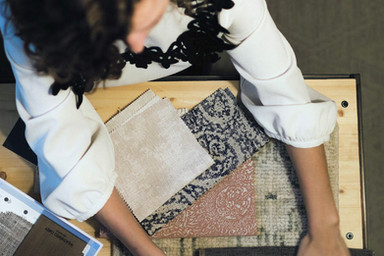Tips for Working from Home from a Working-From-Home Interior Designer
- Lauren Figueroa
- Mar 16, 2020
- 5 min read
Updated: Apr 12, 2023

As I've bounced around the internet a little more than usual the last week, I've so appreciated the way businesses and individuals are coming together to share tips and insights to help our collective community in what might be a longer than we'd hope for period of social distancing.
For example, my Instagram friend Rebekah DeBoer (@heresweethome on Instagram) has been sharing helpful tools/schedules for families as they face the reality of kids at home all day. My gal Jenna Kutcher created a free daily "control" planner to help us focus on the things we can control in a time when so much is out of our control (snag that here). And those are just a couple examples.
There’s a Steelcase article circulating on LinkedIn right now titled Working from Home: Real Life Lessons. As I was scrolling through the post, a quote from Stephan Derr, VP of Sales in Germany/Netherlands, caught my attention:
“This situation has validated how important physical places are to how I feel, how I get work done, and how I connect with people.”
Isn't that just the truth?! I'm in the industry of creating SPACES, and one of the reasons I was drawn to this practice is because I've always been very attuned to how the spaces in which I spend my time impact how I feel, my productivity, and my overall quality of life. On top of that, I've also worked from home for a looong time, so I thought this was an area where I could lend some helpful tips to the large number of people now at home who are used to having some space between work and home.
Let's jump in!
1. Dress for Work
As tempting as it might be to stay in your jammies, I am 100% more productive, I feel more professional, I'm more creative and more confident when I dress for work. That looks different for everyone. For me, it's "snappy casual": black jeans/nice top. I do my hair and makeup. I "go to work". Even if I'm only having phone conferences that day, I find the practice of getting ready and looking sharp helps me get in the mindset of "work time" and get the work done. If you're used to getting ready for work, this will allow your brain one less change in a time when so much else is changing.
2. Designate a Workspace BUT Observe Your Personal Working Style
This step is especially important if you have other people/kiddos now at home with you. If it's possible based on the space in your home and the needs of the family, I suggest setting up a designated workspace for yourself. Larry and I both have workspaces that are away from the main areas of the house where we can take calls, leave out projects we're working on, and close the door when we're done. This gives us a boundary between work and home, and is SUPER helpful, for sure.
However! Be open to the fact that you may be a roamer—like me! I find that I work best when I'm able to move around the house to different spaces: I bop from the sofa to my office, to our bedroom, to the sunroom, and—when it's warm enough!—the front porch. It's sometimes based on which room is the sunniest at the time, or what type of task I'm working on. For example, as I'm writing this, I'm sitting on the floor in our bedroom, which has east-facing windows and is very nice in the morning. Later, I'll be working on sourcing furniture, which involves a lot of printing and visual activity, so I'll move to my office where I can pin things up on my bulletin board.
Some theories will tell you to always work from the same place in order to get into the flow or the work mindset, and I'll be honest, I tried that for a long time without much success...however, that might work for you! Everyone is different, so observe your tendencies over the next week or so, and try out working from different places if you start to feel antsy in your designated work area.
3. Setting up Your Workspace
In your designated workspace, be sure to have the following:
An appropriately sized work surface. There's nothing more obnoxious than working at a too-small desk. Most of us like more room than less, so even if it means pulling out the folding table you use for family gatherings, make sure you have enough room to spread out. You can also get creative! Snag a piece of plywood from the garage or Home Depot (if they are currently still serving guests), and prop it up on some type of base, like so:

Adequate lighting. If you can, set up your designated space in an area with lots of natural light. South and west-facing windows are prime! I do not get a lot of natural light in my home office, so if that's the case for you as well, pull a couple of lamps from around the house and light up your workspace. Squinting isn't good for morale, so light up that space!
Feng Shui Your Space. Whether you're a believer in this amazing concept of energy and flow or not, juuuust give it a try. When I finally moved my desk into the Power Position, I was amazed at how much more at ease I felt in my workspace. The concept of the Power Position is that you should face out into the center of the room, so that the full space is visible to you, including the entrance (or all entrances) of the room. If it works in your space, try not to face a wall—I realize this is impossible in some spaces, but if you can help it, it makes a big difference!
Have at least One Plant in Your Space. Plants help your space feel less stagnant. They are living things, after all, and they bring energy and life into your space.
4. Take Breaks, and Communicate Needs to Your Housemates
Breaks are key. Some say you should take a five-minute break every 50 minutes. Go grab some water from the kitchen, make a quick snack, or walk the stairs a few times.
Communicating with those who live (and may now be working) in your home is also key. My husband and I both work from home, and we've learned that it's helpful to communicate about work needs. Sometimes we like to work together in the same room. Sometimes we need space to focus and do creative work. When one of us has a call, we ask to leave our dog in with the other so she doesn't disturb the call. Whatever that means for you, in a time of tension and unknown, make sure your partners and family know what you need.
5. A Collection of Simple Work-From-Home Setups
Lastly, I'll leave you with a handful of simple but functional (and beautiful!) work-from-home setups—including a couple of alternative areas that would be nice for changing up your location—to give you some ideas about how you can setup your own space. If you have any questions about setting up your space or other aspects of working from home, feel free to leave a comment and we'll work to get them answered!
I hope you find this is helpful!
Stay healthy and safe,
Lauren









Work with Lauren Figueroa Interior Design

LFID is a full-service interior design firm serving West and Southeast Michigan known especially for our Designed in a Day service.
We work with clients from Detroit to Novi to Clarkston, and Grand Rapids to Holland to Traverse City—and anywhere in between! We pride ourselves on creating bespoke, people-centered spaces—because after all, people are what this life is all about!


































Comments